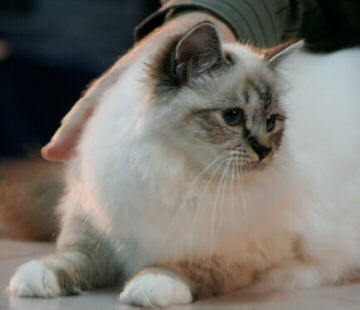 Often referred to as the “Sacred Temple Cats of Burma”, the legend of the Birman cat tells us that the original Birman cats were the companion cats of the Kittah Priests and guardians of the Temple of Lao Tsun. These original cats were described as white cats with long hair and yellow eyes. The legend also tells us that the temple’s golden goddess, Tsun-Kyan-Kse, had deep blue eyes and was attended by the head priest, Mun-Ha, who had as his companion, a cat named Sinh.
Often referred to as the “Sacred Temple Cats of Burma”, the legend of the Birman cat tells us that the original Birman cats were the companion cats of the Kittah Priests and guardians of the Temple of Lao Tsun. These original cats were described as white cats with long hair and yellow eyes. The legend also tells us that the temple’s golden goddess, Tsun-Kyan-Kse, had deep blue eyes and was attended by the head priest, Mun-Ha, who had as his companion, a cat named Sinh.
When the temple was subsequently attacked, Mun-Ha was killed and at the moment of his death, the faithful Sinh stood with all feet upon his master and faced the goddess Tsun-Kyan-Kse. Immediately, the cat’s fur took on a golden mist, his eyes turned as blue as those of Tsun-Kyan-Tse and his face and legs became the colour of earth. However, where his paws touched his master Mun-Ha, they became as white as snow. It is said that all the other temple cats were likewise affected and that seven days later, Sinh died, “taking with him the soul of Mun-Ha to paradise”.
Mystery also surrounds the modern history of the Birman Cat. We do know that circa 1919 a pair of Birman cats were taken from Burma to France. The male did not survive the journey, but the female, who was pregnant, did. From this very meagre beginning, the Birman had its foundation in the west as a modern breed. The breed was subsequently recognised by the French as a separate breed in 1925. However by the end of World War II, the breed was almost obliterated and a program of outcrossing to re-establish the breed began. Most registries required at least 4 or 5 generations of pure breeding after outcrossings before fully accrediting the cats for championship competition. Birmans were eventually recognised by the GCCF in 1966.
 The Birman is a strongly boned cat of good length, yet muscular and solid, with a distinctive head and ear set, firm chin and medium length Roman nose. The coat is long and silky, of a texture that does not mat. The colour is light, preferably with a golden cast as if dusted with gold. The face, legs and tail are “pointed” much like a Siamese or Himalayan, in colour and patterns based upon the primary colours of sealpoint, bluepoint, chocolatepoint and lilacpoint. There should be a strong definition between point colour and coat colour. In recent times, colour development within the breed has brought us redpoints and a range of tortiepoints, as well as cinnamonpoint and fawnpoint. All of these colours are now also possible in Lynx (Tabby) and Smoke varieties.
The Birman is a strongly boned cat of good length, yet muscular and solid, with a distinctive head and ear set, firm chin and medium length Roman nose. The coat is long and silky, of a texture that does not mat. The colour is light, preferably with a golden cast as if dusted with gold. The face, legs and tail are “pointed” much like a Siamese or Himalayan, in colour and patterns based upon the primary colours of sealpoint, bluepoint, chocolatepoint and lilacpoint. There should be a strong definition between point colour and coat colour. In recent times, colour development within the breed has brought us redpoints and a range of tortiepoints, as well as cinnamonpoint and fawnpoint. All of these colours are now also possible in Lynx (Tabby) and Smoke varieties.
However the most distinctive colour feature is the ideally symmetrical white gloves on the front feet which in an ideal specimen cut across in an even line and the white gauntlets on the back feet which should spearheaded at least half way up the hock. The challenge for the breeder of Birmans is to create a cat of notable type with the correct colour and markings all in the one specimen, not an easy feat!
The Birman has a gentle but playful disposition, is quiet but funloving and is an ideal companion cat for any household.
The Breed is extremely popular in New Zealand, where it has attained an enviable public profile due to the hard work of breeders working within the Birman Specialist Clubs established for the promotion and preservation of the breed. This success has carried through to the Cat Show circuit, where Birman cats have triumphed in Championship and attained the highest honour possible, that of BEST CAT nationally. The quality of New Zealand Birmans is recognised world-wide and many excellent specimens have been exported to all corners of the globe.







